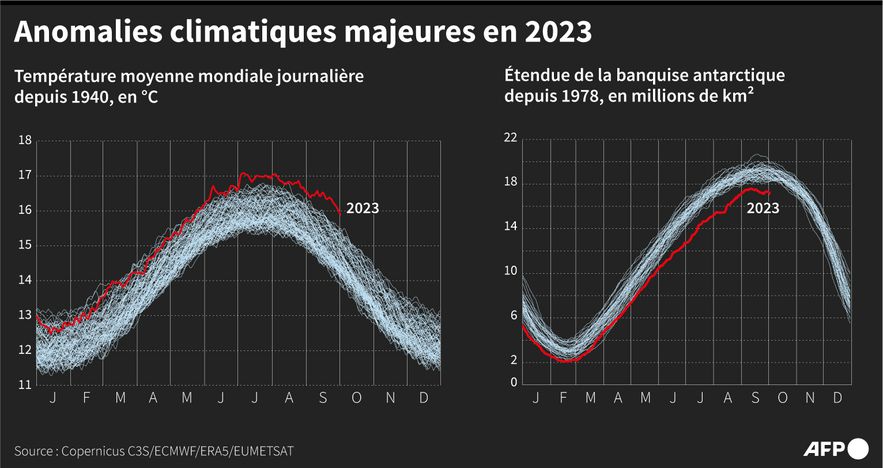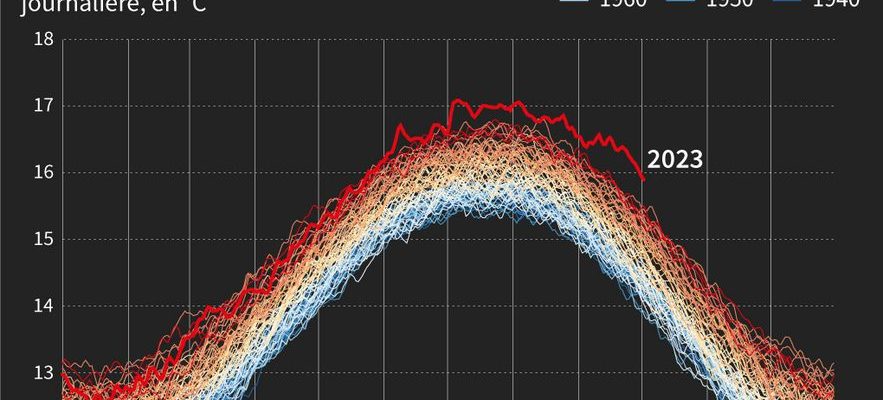Global temperatures continue to crush records: after an unprecedented summer and an even more surprising month of September, 2023 is now the hottest year ever measured over the first nine months, approaching an anomaly of 1, 5°C compared to the pre-industrial era.
From January to September, “the global average temperature is 1.40 °C above the pre-industrial average (1850-1900)”, before the effect on the climate of humanity’s greenhouse gas emissions, the Climate Change Service (C3S) of the European Copernicus Observatory announced Thursday.
And this average, already 0.05°C higher than for the record year of 2016, could further increase over the last three months of the year, given the strengthening of El Nino. This cyclical weather phenomenon over the Pacific, synonymous with additional warming, generally peaks around the Christmas period.
Global average temperature
© / afp.com/Paz PIZARRO, Sylvie HUSSON
+1.5°C will be reached by the years 2030-2035
“It is not certain that 2023 will reach 1.5°C. But we are quite close to it,” Carlo Buontempo, director of C3S, told AFP. Reaching this symbolic bar would not mean that the most ambitious limit of the Paris agreement has been reached, because the latter refers to the evolution of the climate over long periods, decades and not single years. The IPCC, bringing together climate experts mandated by the United Nations, predicts that this threshold of 1.5°C will be reached by the years 2030-2035.
And the World Meteorological Organization estimated in the spring that the bar would be crossed for the first time in a full year only in the next five years. In the meantime, “September 2023 was the hottest September on record globally”, continuing a series of global monthly records started in June. July 2023 holds the absolute record, all months combined.
With an average temperature of 16.38°C on the surface of the globe, the past month exceeds the record of September 2020 by an “extraordinary” margin of 0.5°C, Copernicus said on Thursday. September 2023 is thus “1.75°C warmer than the average September over the period 1850-1900”, added Copernicus.

Major climate anomalies in 2023
© / afp.com/Paz PIZARRO, Sylvie HUSSON, Clement KASSER
All continents affected by these anomalies
While variations in global temperatures are generally measured in a few tenths of a degree, September 2023 is 0.9°C above the September average over the period 1991-2020, i.e. “the strongest monthly anomaly” ever measured by Copernicus, whose complete database dates back to 1940.
All continents were affected by extraordinary anomalies. In Europe, September 2023 set a new continental record for the first month of meteorological autumn; it was over 35°C in France until the beginning of October.
In the same month, torrential rains from Storm Daniel, likely worsened by climate change according to preliminary studies, devastated northeastern Libya and Greece. The south of Brazil and Chile also experienced the flood in September while the Amazon is currently hit by an extreme drought, which affects more than 500,000 inhabitants. And the poles are losing ice: the Antarctic sea ice remains at a record low level for the season, while the Arctic sea ice is 18% below average, according to the C3S.
Average sea temperature close to 21°C
The overheating of the world’s seas, which absorb 90% of the excess heat caused by human activity since the industrial era, plays a major role in these observations. For the Copernicus measurement system, the average sea temperature reached 20.92°C in September, a new monthly record and the 2nd highest measurement behind August 2023.
Faced with this situation, humanity’s responses are “insufficient while the world […] is collapsing” and is approaching a “breaking point”, lamented Pope Francis on Wednesday, in a text in the form of a cry of alarm two months before a decisive UN climate conference.
During this COP28, in Dubai, the theme of phasing out fossil fuels will be at the heart of tough negotiations between countries, unable to date to reconcile the requirements of the Paris agreement to limit warming and ensure the aspirations for the development of all humanity.
